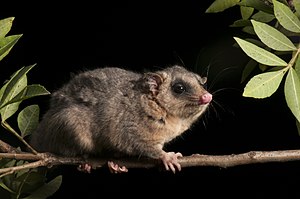Tate's woolly dwarf bag rat
| Tate's woolly dwarf bag rat | ||||||||||||
|---|---|---|---|---|---|---|---|---|---|---|---|---|

Tates woolly dwarf bag rat ( Marmosa paraguayana ) |
||||||||||||
| Systematics | ||||||||||||
|
||||||||||||
| Scientific name | ||||||||||||
| Marmosa paraguayana | ||||||||||||
| Tate , 1931 |
Tate's woolly pygmy rat ( Marmosa paraguayana ), also called the southeastern pygmy rat , is a species of marsupial that grows in southeastern Brazil, from southern Bahia in the north to the north of Rio Grande do Sul in the south, in the extreme northeast of Argentina ( province of Misiones ) and in the Occurs east of Paraguay .
description
Tate's woolly dwarf bag rat reaches a head body length of 12 to 24 cm, and has a 15 to 26 cm long tail and a weight of 56 to 230 g. The tail is on average around 25% longer than the head and trunk combined. The fur is long, soft and woolly. The back is a solid gray, sometimes with a slight brownish tinge. The head is brownish and orange between the eyes and above the nose. There are dark circles around the black eyes that do not extend to the base of the ear. They are less pronounced than in other dwarf pouch rats. The ears are round and pink to brownish. The belly is brownish to orange and gray at the transition to the sides of the body. The feet are light brown to pink. The hairless section of the tail is brown, the last third is white or mottled white. The close to the body 30 mm of the tail are insisted. Females do not have a pouch. The number of teats is eleven, five on each side and one in the middle. The karyotype is 2n = 14, FN = 24.
Habitat and way of life
Tate's woolly pygmy bag rat lives in primary and secondary forests , both in closed forest stands and in fragmented forests. In eucalyptus forests the species occurs when the shrub and herb layer is formed by native species. It is largely arboreal (tree-dwelling) and only goes to the ground to switch between forest fragments, which is very rare. It covers distances of up to 300 meters. Tate's woolly pygmy pouch rat is nocturnal and has its peak shortly after sunset. After that, their activity decreases more and more as the night progresses. All specimens previously caught in traps were caught at heights of three to twelve meters above the ground.
The diet of Tate's woolly pygmy pouch has been studied far better than that of the rest of the pygmy pouch rats. In surveys in southeastern Brazil, more than 80% to 100% of the feces samples from Tate's Woolly Dwarf Rat contained arthropod remains and 40 to 58% contained remains of fruit. The prey animals include beetles, hymenoptera , especially ants, caterpillars, grasshoppers, spiders, Schnabelkerfe , cockroaches , woodlice , harvestmen and small birds. Present in the faeces seeds derived from ants trees , Amaioua , refractive shrubs , Flamingo Flower ( Anthurium harrisii ) Clidemia , Miconia , passion flower , philodendron , pepper , Tapirira .
Tate's woolly pygmy bag rat builds nests in tree hollows, in bromeliads, in termite burrows or between lianas at heights of 4.5 to 10 meters. The palm species Astrocaryum aculeatissimum is preferred , where the opossum builds its nests between dead leaves. Man-made nest boxes are also accepted. The animals reproduce during the rainy season from October to May. The females, which become sexually mature at around six months of age, can have pups once or twice in a year. The number of young animals is between six and eleven.
status
The IUCN classifies the population of Tate's pygmy pouch rat as Least Concern. It is widespread, copes well with the presence of people and human interference with their habitat, also lives in numerous protected areas, and is common. Since large parts of their habitat are densely populated by humans, it is possible that individual populations of Tate's woolly pygmy bag rat will die out in the future.
supporting documents
- ↑ a b c d e f Diego Astúa: Family Didelphidae (Opossums). in Don E. Wilson , Russell A. Mittermeier : Handbook of the Mammals of the World - Volume 5. Monotremes and Marsupials. Lynx Editions, 2015, ISBN 978-84-96553-99-6 . Page 143.
- ↑ Marmosa paraguayana in the endangered Red List species the IUCN 2018 Posted by: Brito, D., Astua de Moraes, D., de la Sancha, N. & Flores, D., 2015. Retrieved on June 30 of 2019.
